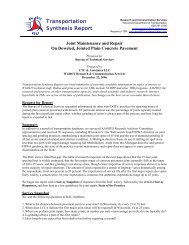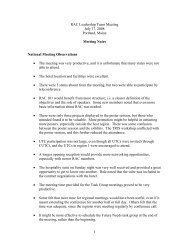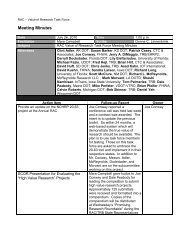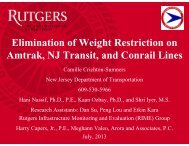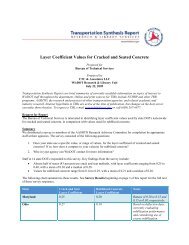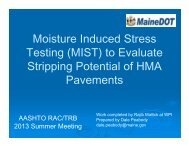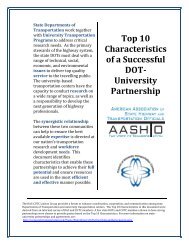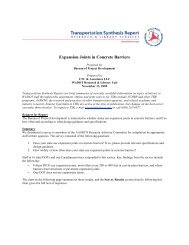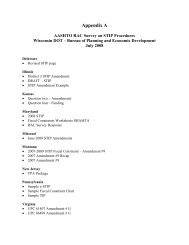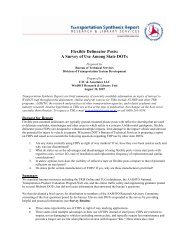PART IV: Summary of Comments - SCOR/RAC
PART IV: Summary of Comments - SCOR/RAC
PART IV: Summary of Comments - SCOR/RAC
You also want an ePaper? Increase the reach of your titles
YUMPU automatically turns print PDFs into web optimized ePapers that Google loves.
<strong>PART</strong> <strong>IV</strong>: <strong>Summary</strong> <strong>of</strong> <strong>Comments</strong>17-May-10Reviewer <strong>Comments</strong> Distribution <strong>of</strong> Ratings■ Not much benefit for MS. Don’t see the research objective mention anything to do with pedestrian behavior.Other■ The objective <strong>of</strong> this project is essentially the same as SHRP project S09: Site-Based Video system Design andDevelopment. However, the SHRP project is specifically focused on vehicles and does not include pedestrians, so there isno overlap.Item #124:D-06Modified Portland Cement Concrete for Crack FreeBridge Decks(17)(46)NR 0 1 2 3 4 5<strong>SCOR</strong> 2 4 7 4<strong>RAC</strong> 1 9 11 12 8 4 4Standing Committee on Research■ Considerable research has been done on cracking in decks and cracking continues to be a problem. We know the causesbut do not try to apply the cures. This project will not likely provide new information that will help reduce the problem■ California has on-going research in this area.■ Eliminating deck cracking has been studied extensively without arriving at a cost effective solution. Suspect that thelikelihood <strong>of</strong> success for this research is very low. Kansas DOT currently has an onoing research project focused ondevelping a crack-free bridge deck.■ May duplicate ongoing work.■ [Rating: 5] Bridge deck deterioration is an issue <strong>of</strong> major significance. Investing research funding in innovative solutionsto reduce deck cracking would be money very well spent.Research Advisory Committee■ There is an ongoing pooled fund study with Kansas■ Deck repair/replacement cost reduction.■ Other factors involved than just the cement.■ Ongoing poole fund study with Kansas with respect to construction <strong>of</strong> several bridge decks utilizing low cracking highperformance concrete.■ Use <strong>of</strong> polymers in concrete is not the practical cost effective means to solve the bridge deck cracking. We need to returnto past practices which produced crack free decks or post tensioned structures to ensure expected service life.■ Has some promise but does not addressother issues that affect concrete cracking in bridges■ I concur with the panel <strong>of</strong> specialists drawn from the AASHTO Highway Subcommittee on Materials ins<strong>of</strong>ar as ratingthis as a low priority research need. Engineers have been researching ways <strong>of</strong> increasing concrete tensile strength foryears in order to reduce cracking. This is just another spin on previous research in the context <strong>of</strong> crack free bridge decks.Other■ [Rating: 1] The proposed research focuses on the cement as the primary contributing factor to cracking <strong>of</strong> bridge decks.However, other concrete materials (e.g., aggregates, other cementitious materials, and admixtures), construction practices(e.g., curing), and design details also influence cracking.- NCHRP Project 12-37, Transverse Cracking in Newly Constructed Bridge Decks (NCHRP Report 380), addressedmany <strong>of</strong> the factors involved in bridge deck cracking; other numerous research projects have also studied this topic.<strong>IV</strong>-91



